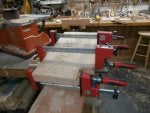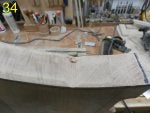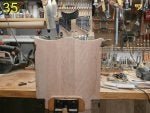Sometimes you just want to challenge yourself. Such is the case with my latest project. A Maloof inspired rocking chair. This has been on my "bucket" list for sometime and I finally got a good reason to build one. This will be for a friends son's wedding gift in the spring.
As with just about all my projects, I did a great deal of research. A Maloof rocker was a given, but just who's plans was I going to use? In the end it came down to
A Charles Brock interpretation:
MALOOF INSPIRED ROCKER Instructional DVD, Book and Rocker Patterns - Home
Between the plans, a step by step book and a couple of DVD's I should have all my bases covered as far as the basic construction of the rocker goes. Cost of the plans was about 90 bucks. Not cheap, but considering what all I got, I figure it to be a fair price to pay. I ordered em up and they arrived quickly. First thing I did was open up the paper template guides that came with the purchase. Really kinda rough was my first impression. I guess I was thinking more along the lines of blueprints. This is however a "sculptured" chair. Just about everything gets shaped to some extent. The templates are just a guide, cut em close and go from there. Read over the book and viewed the rocker DVD. All good stuff. Well written, well explained. So should be easy enough, as easy enough goes *L* to follow along with. The 2nd DVD is on shaping the rocker. That part I am really looking forward to. This is where you kinda add your own twist to the project if you like. A couple areas of the construction allow you to do that to some extent, but I"m not sure I wanna fiddle around too much. Especially considering what I paid for the lumber to do this project. 65bf of 10/4 figured cherry. I wanted some really NICE wood for this project. This one is special for a couple of reasons and wood choice was important. When I have to have the right wood for a project, I go to one place: Horizon Wood Products in Kersey Pa.. These boys are a good 3 hr drive away, but I have never been disappointed in anything I've gotten from there. Great guys to deal with. Outstanding facility that is just immaculate. I could walk around this place all day. The wood is just incredible. You'd have to see it to believe it. Pricing is a bit on the high side, however I've never had reason to complain.
Horizon Evolutions: Unique American Hardwood For Sale
After a couple of emails regarding the last chess table I posted, I thought maybe Ill give step by step photo shoot a try. So bear with me. If there is interest I'll keep it going throughout the entire project, if not, I'll let it fade away and just hit ya up with the end result.
Here are a few pictures of the rough cut 10/4 after getting it home. I let it sit a few days to acclimate before I began carving it up. 4 boards, 8-9' long, 10-14"s wide. The last couple pics give you an idea of what you can expect when you go out and buy lumber like this. It may look like alot of wood when you get started, but once you start breaking it down, cutting away checks and sap wood..squaring it up, its amazing sometimes what you got left.
As with just about all my projects, I did a great deal of research. A Maloof rocker was a given, but just who's plans was I going to use? In the end it came down to
A Charles Brock interpretation:
MALOOF INSPIRED ROCKER Instructional DVD, Book and Rocker Patterns - Home
Between the plans, a step by step book and a couple of DVD's I should have all my bases covered as far as the basic construction of the rocker goes. Cost of the plans was about 90 bucks. Not cheap, but considering what all I got, I figure it to be a fair price to pay. I ordered em up and they arrived quickly. First thing I did was open up the paper template guides that came with the purchase. Really kinda rough was my first impression. I guess I was thinking more along the lines of blueprints. This is however a "sculptured" chair. Just about everything gets shaped to some extent. The templates are just a guide, cut em close and go from there. Read over the book and viewed the rocker DVD. All good stuff. Well written, well explained. So should be easy enough, as easy enough goes *L* to follow along with. The 2nd DVD is on shaping the rocker. That part I am really looking forward to. This is where you kinda add your own twist to the project if you like. A couple areas of the construction allow you to do that to some extent, but I"m not sure I wanna fiddle around too much. Especially considering what I paid for the lumber to do this project. 65bf of 10/4 figured cherry. I wanted some really NICE wood for this project. This one is special for a couple of reasons and wood choice was important. When I have to have the right wood for a project, I go to one place: Horizon Wood Products in Kersey Pa.. These boys are a good 3 hr drive away, but I have never been disappointed in anything I've gotten from there. Great guys to deal with. Outstanding facility that is just immaculate. I could walk around this place all day. The wood is just incredible. You'd have to see it to believe it. Pricing is a bit on the high side, however I've never had reason to complain.
Horizon Evolutions: Unique American Hardwood For Sale
After a couple of emails regarding the last chess table I posted, I thought maybe Ill give step by step photo shoot a try. So bear with me. If there is interest I'll keep it going throughout the entire project, if not, I'll let it fade away and just hit ya up with the end result.
Here are a few pictures of the rough cut 10/4 after getting it home. I let it sit a few days to acclimate before I began carving it up. 4 boards, 8-9' long, 10-14"s wide. The last couple pics give you an idea of what you can expect when you go out and buy lumber like this. It may look like alot of wood when you get started, but once you start breaking it down, cutting away checks and sap wood..squaring it up, its amazing sometimes what you got left.
































